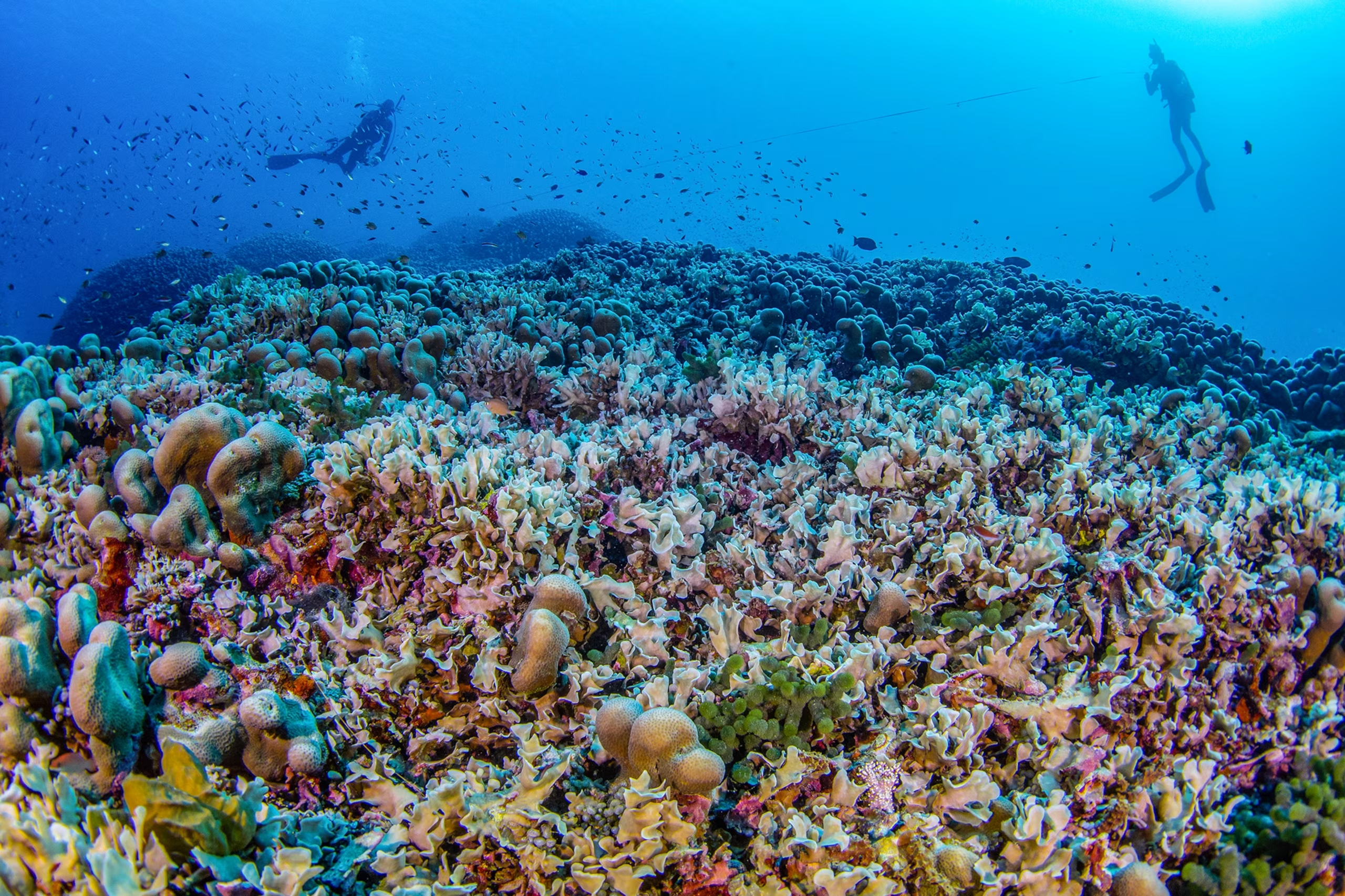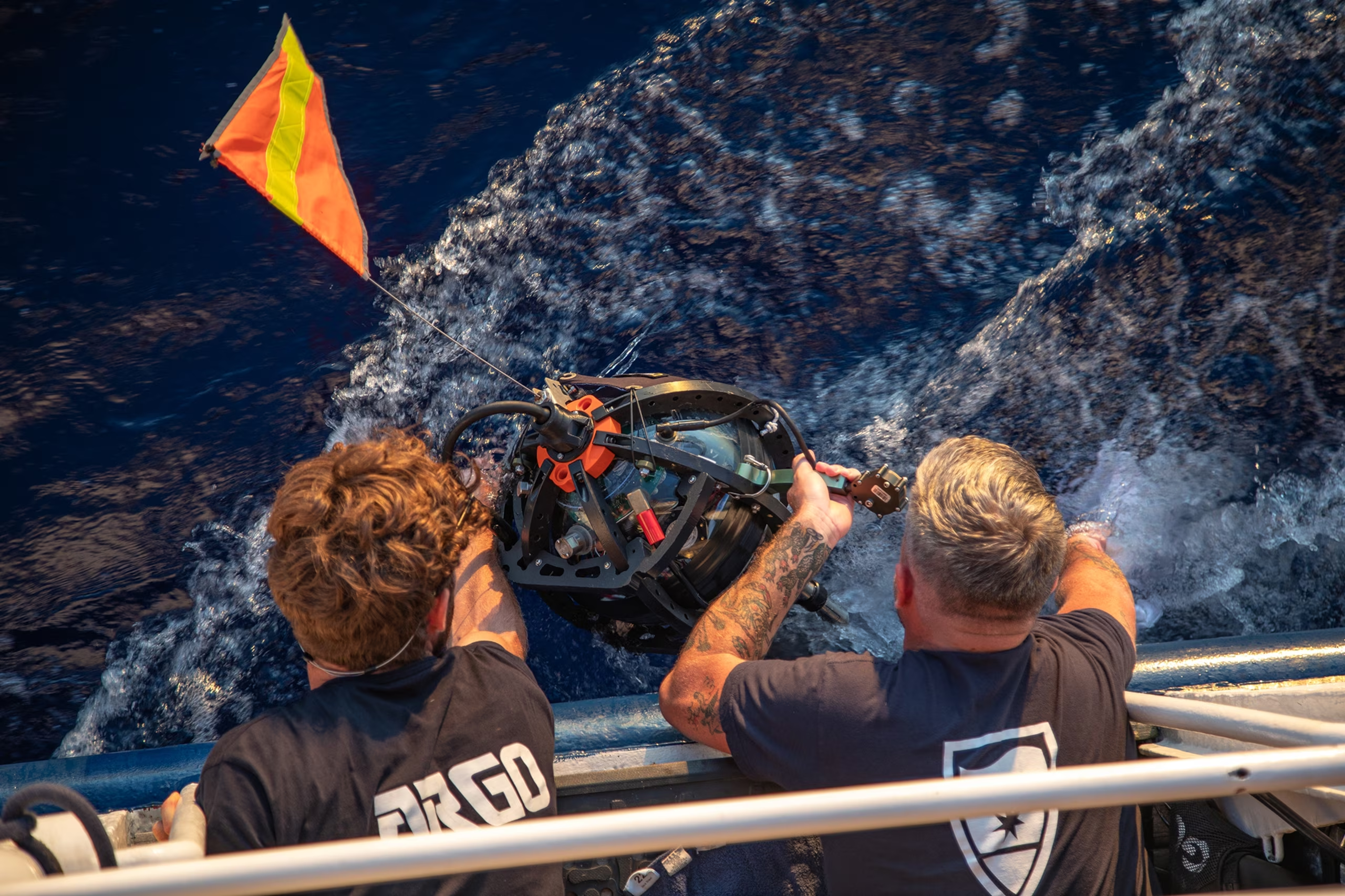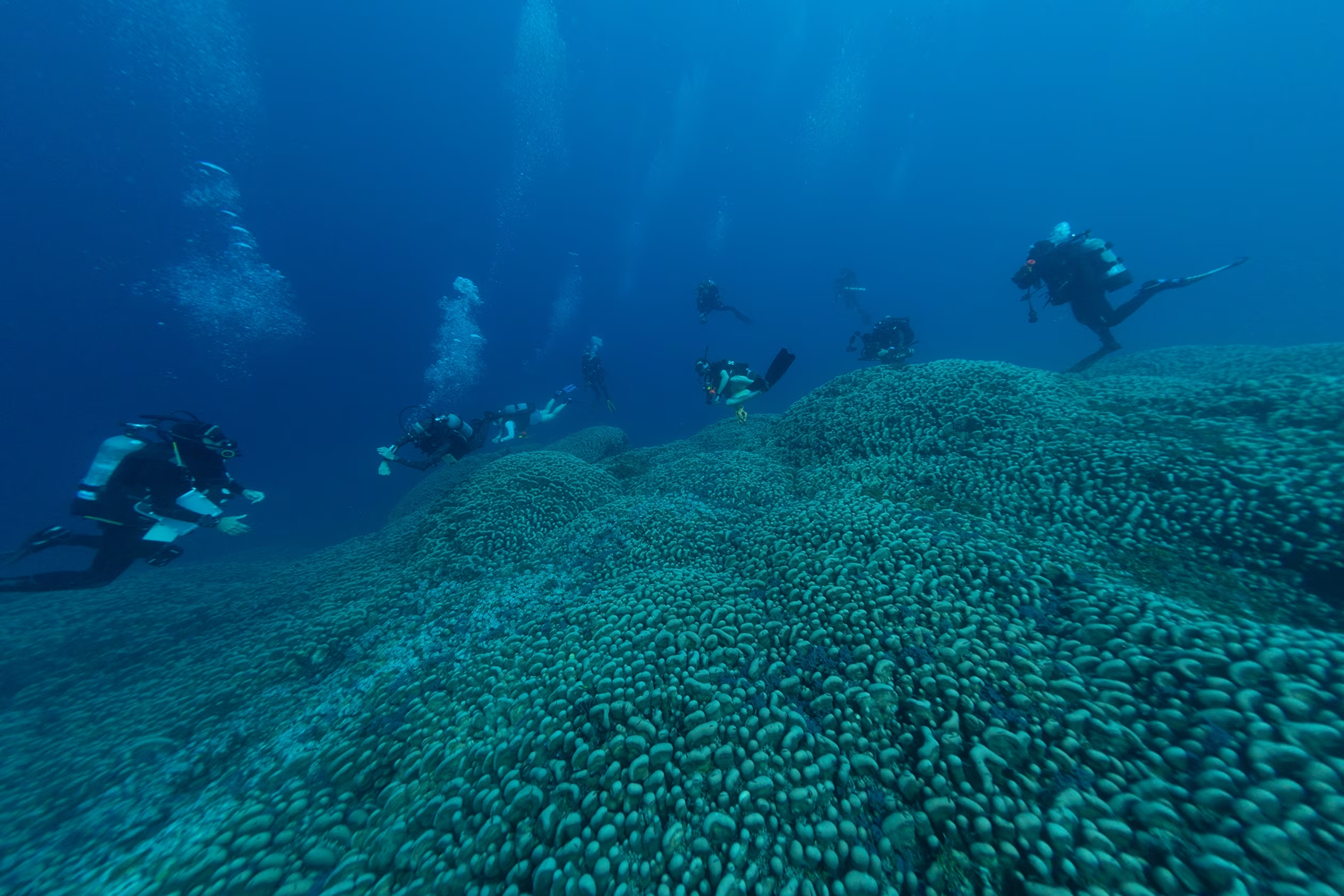
“Visible from space, the mega coral is three times larger than the previous record-breaker, is believed to be about 300 years old, storing a record of ocean conditions from past centuries.”
A group of scientists working aboard a research vessel in the southwest Pacific Ocean has discovered the world’s largest coral.
Measuring 34 meters wide, 32 meters long and 5.5 meters high, with a circumference of 183 meters, the gigantic organism is a complex network of coral polyps — tiny individual creatures — that have grown over a span of three centuries. In contrast to a reef — which is a network of many coral colonies — this structure is a standalone coral that has grown uninterrupted for hundreds of years.
Discovered in the Three Sisters island group by members of the National Geographic Pristine Seas team during their scientific expedition to the Solomon Islands, the mega coral — mostly brown but with splashes of bright yellows, blues and reds — is covered with ripples of waves, mirroring the ocean’s surface. It is longer than the planet’s biggest animal, the blue whale. The coral, species Pavona clavus, provides essential habitat, shelter and breeding grounds for an array of species from shrimp and crabs to fish.

Team members deploy a deep-sea camera from the Argo research vessel. The ‘mega coral’ is so large it can be seen from space, but the coral has remained hidden from view just offshore. Photograph by Caitlin Bailey, National Geographic Pristine Seas
“Just when we think there is nothing left to discover on planet earth, we find a massive coral made of nearly one billion little polyps, pulsing with life and color,” said Enric Sala, National Geographic Explorer in Residence and founder of Pristine Seas. “This is a significant scientific discovery, like finding the world’s tallest tree. But there is cause for alarm. Despite its remote location, this coral is not safe from global warming and other human threats.”
The coral is so colossal that it can be seen from space. To the naked eye, it may look like an immense rock just beneath the surface of the ocean. When team members initially spotted the structure, they thought it might be remnants of a shipwreck due to its size.
Manu San Félix, Pristine Seas’ underwater cinematographer dove down for a closer look and discovered it was an exceptionally big Pavona clavus. Despite its size, the coral has never been documented,
with the local community reporting they did not know it was there.
“The ocean provides for our livelihoods and has contributed so much to our national economy and communities,” remarked Solomon Islands Prime Minister Jeremiah Manele. “Our survival depends on healthy coral reefs, so this exciting discovery underlines the importance of protecting and sustaining them for future generations.”
Paul Rose, Pristine Seas’ Head of the Expedition to the Solomon Islands siad, “Making a new discovery of this significance is the ultimate dream of every scientist and explorer, and we are delighted that this mega coral, which will help inspire ocean conservation decision making, was found here in the beautiful Solomon Islands.”
Corals are havens for marine life. Pavona clavus’ dome-like shape shelters juvenile reef fish, crabs and other reef invertebrates that local communities rely on for food.The polyps that form this enormous coral come from larvae that settled on the seafloor and multiplied into millions of other genetically identical polyps over the centuries.

The newly discovered coral measures 112 by 105 feet. It’s larger than the average blue whale, the largest animal on Earth and is visible from space. Photograph by Caitlin Bailey, National Geographic Pristine Seas
“Large adult coral colonies like this contribute significantly to the recovery of coral reef ecosystems due to their high reproductive potential,” remarked Eric Brown, coral scientist for the Pristine Seas expedition to the Solomon Islands. Brown, who is one of the world’s premier coral scientists, had identified and measured the previous record-holding coral, located in American Samoa. “While the nearby shallow reefs were degraded due to warmer seas, witnessing this large healthy coral oasis in slightly deeper waters is a beacon of hope.”
Discovery of the mega coral comes when research has shown that only 8.4% of the ocean is protected to some degree. Scientific studies recommend that the world protect at least 30% of the ocean to maintain its role in absorbing much of our carbon pollution–as well as providing food, economic benefits and employment for hundreds of millions of people. A recent study found that we need about 190,000 small MPAs in coastal regions and 300 large MPAs in remote areas by the end of 2030 to achieve the target.
“It is a natural monument that has seen the arrival of the first Europeans to these waters,” said San Félix, who was the first to spot the record-breaking coral. “Illustrious figures of humanity have coexisted with this colony: Newton, Darwin, Curie, Gandhi, Einstein… and it has survived them. It now stores information on how to survive throughout the centuries.The genetic code of these simple polyps is an enormous encyclopedia that has written how to survive multiple climatic conditions, and until now it does so in the face of ocean warming.” Solomon Islands hosts the second highest coral diversity on the planet, boasting more than 490 known species, both hard and soft. It is also home to one of the world’s most active underwater volcanoes, Kavachi.
“The Solomon Islands is a custodian of the ocean and the Coral Triangle’s wonders, including this breathtaking coral,” remarked Collin Beck, Permanent Secretary of the country’s Ministry of Foreign Affairs and External Trade. “There is so much to learn about the richness of marine life and the ocean ecosystem, but this finding opens doors of knowledge. More scientific research is needed to better understand our rich biodiversity and our planet.”
In mid-October, 18 scientists and filmmakers from National Geographic Pristine Seas embarked on an expedition to study ocean health in parts of the Solomon Islands. The months-long research trip — a partnership between National Geographic Pristine Seas, the Government of the Solomon Islands, key members of Ocean12, and the Solomon Island Ministry of Education and Human Resources Development (MEHRD) — is using cutting-edge technology to better understand the country’s marine ecosystem in hopes of advancing ocean conservation. Living and working aboard the Argo research vessel, the team of local and international crew members will assess the ocean’s health with deep sea cameras, SCUBA dive surveys, seabird counts, underwater visual surveys, environmental DNA (eDNA) sampling, and a new state-of-the-art submersible rated to 1,300 m depth.
Pristine Seas conducts research to support countries to fulfill their commitments to ocean
protection. The team of international and local scientists and filmmakers study the health of the
ocean, documenting its wonder through still photography and cinematography, to support ocean
conservation efforts in collaboration with local communities.
National Geographic Pristine Seas:
Pristine Seas works with Indigenous and local communities, governments, and other partners to help protect vital places in the ocean using a unique combination of research, community engagement, policy work, and strategic communications and media. Since 2008, our program has conducted more than 45 expeditions around the world and helped establish 29 marine reserves, spanning more than 6.8 million square kilometers of ocean. Pristine Seas is part of the global non-profit, the National Geographic Society. Our mission is driven by science and filmmaking — we are fully independent from National Geographic publishing and its media arm.
Banner Photo Credits: National Geographic
















